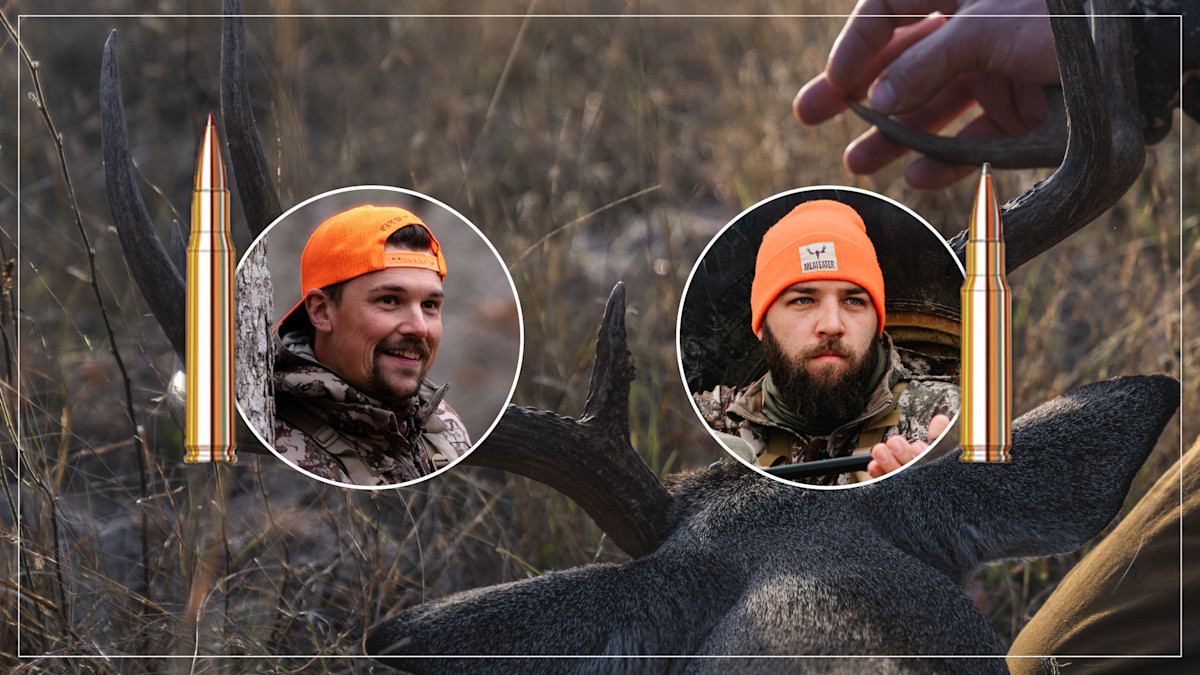
Update: We have a winner! By a comfortable 115-89 vote, Mark's .30-06 defeated Spencer's .308 Win. in this semi-final matchup. Supporters of the .30-06 liked its extra power and range, and many had fond memories of taking deer with this classic caliber. Now, Mark's .30-06 will face off in the championship against Tyler's .243 Win. Be looking for that matchup to drop later today.
We gave Mark’s .30-06 Springfield a bye in the first round because, let’s be honest, the ol’ .30-06 is a legend. But it’s being challenged in this semi-final matchup by Spencer’s .308 Win., which has also taken a deer or two in its time and soundly beat Clay's .300 Win. Mag. in the last round.
Which one deserves a chance at the October Madness championship and immortal glory? If you already know, scroll down to the comments and cast your vote. If you need a little more info, we’ve compiled the best argument for each cartridge below.

Don’t forget to vote in the matchup on the other side of the bracket, which you can do here.
The Case for Mark’s .30-06 Springfield
I wasn’t just blowing smoke when I called the .30-06 Springfield a legend. Boone and Crockett reports that with 1,216 entries, the .30-06 is the most popular caliber used on trophies in their record books. Most of those trophies aren’t whitetail, but some are, and it’s easy to see why.
From a power perspective, the .30-06 occupies a middle space between the .300 Win. Mag. and the .308 Win. These 165-grain pills, for example, exit the muzzle with 3,081 ft.-lbs. of energy, which is about 200 ft.-lbs. more than a .308.
Recoil mirrors power, as you’d expect, so the .30-06 will be less comfortable to shoot than the .308 Win. but more comfortable than the .300 Win. Mag. For many hunters, that’s just the right amount of recoil, as it maximizes their rifle’s power while being just pleasant enough to shoot accurately.
The .30-06 is devastating at short ranges and perfectly capable of taking long-range pokes. The 165-grain loads linked above are still cooking along at 1,800 feet-per-second at 500 yards and have dropped 48 inches with a 100 yard zero. That might sound like a lot, but the much-vaunted 6.5 Creedmoor in the same Sig Sauer line has dropped just as much, and the .308 Win. has dropped three inches more. The .308 and the .30-06 produce a similar trajectory, but the .30-06 has dropped a few inches less at each 100-yard increment and offers 200-300 more ft.-lbs. of energy.
At the end of the day, numbers don’t mean nearly as much as personal experience. Many hunters like the .30-06 because it just works–year after year, buck after buck.
"When I find something I can trust, I stick with it,” said MeatEater’s Mark Kenyon. “I wear the same brand of hunting boots I've worn since I was 15; I haven't changed bow sights in nearly a decade; and I've owned only one caliber of deer rifle (not counting straight wall) my entire life. And that is the .30-06.”
Mark’s first .30-06 was given to him by his grandfather, and he still has that gun to this day.
“That gun and my much newer Weatherby Vanguard are both versatile, dependable, and as accurate as I could ever need in a deer rifle,” he said. “As they say, don't fix it if it ain't broke.”
The Case for Spencer’s .308 Win.
The case for Spencer’s .308 Win. over Mark’s .30-06 is much the same as it was in the last round: the .308 offers more than enough juice to take down a whitetail, but it produces less recoil.
That recoil disparity isn’t as great as between the .308 Win. and .300 Win. Mag., but it’s still there. According to Chuck Hawk’s recoil table, the .308 usually hits with about 17 ft.-lbs. of recoil while the .30-06 can top 20 ft.-lbs. with heavy bullets. If you want more detail on the recoil/power argument, check out last round’s matchup article.
Many of you who gave the nod to the .308 also mentioned that the short-action cartridge can be chambered in shorter, lighter rifles. This is a great point that applies in this matchup as well.
While rifles can be fitted with barrels of any length, the .308 doesn’t require as much runway to burn its powder, and so manufacturers can get away with using shorter barrels. Weatherby’s Mark V Hunter, for example, uses a 22-inch barrel for its .308 model and a 24-inch barrel for its .30-06 model. The .308 cuts two inches in overall length and weighs only 6 pounds compared to the .30-06’s 6.2 pounds. Maybe that matters to you. Maybe it doesn’t. But it’s worth noting when making your decision.
It’s also worth noting that the .308 Win. can be more easily found in rifles of various different actions, specifically in semi-auto, AR-type rifles. Some hunters wouldn’t be caught dead toting an AR into the deer woods. But others appreciate the reliability and flexibility of the platform, so it’s something to keep in mind.
Ultimately, the .308 has earned a dedicated following among whitetail hunters because it maximizes a variety of attributes deer hunters value. It’s not too powerful, but it’s powerful enough; it can be found in short, lightweight rifles; it doesn’t hammer your shoulder, and rifles are inexpensive and readily available.
“It really is a sweet spot among the popular deer calibers,” Spencer said. “It's like having the bullet weight of a .30-06 with the recoil of a .270 and the ammo availability of a .223."
So, who you got? Comment below to cast your vote. If you want to explain your reasoning, feel free. But you don’t have to. The cartridge that gets the most votes by 11:59 pm MT on Thursday, October 5 will advance to the next round.
Click here to check out all the kickass deals happening right now for Whitetail Week.



